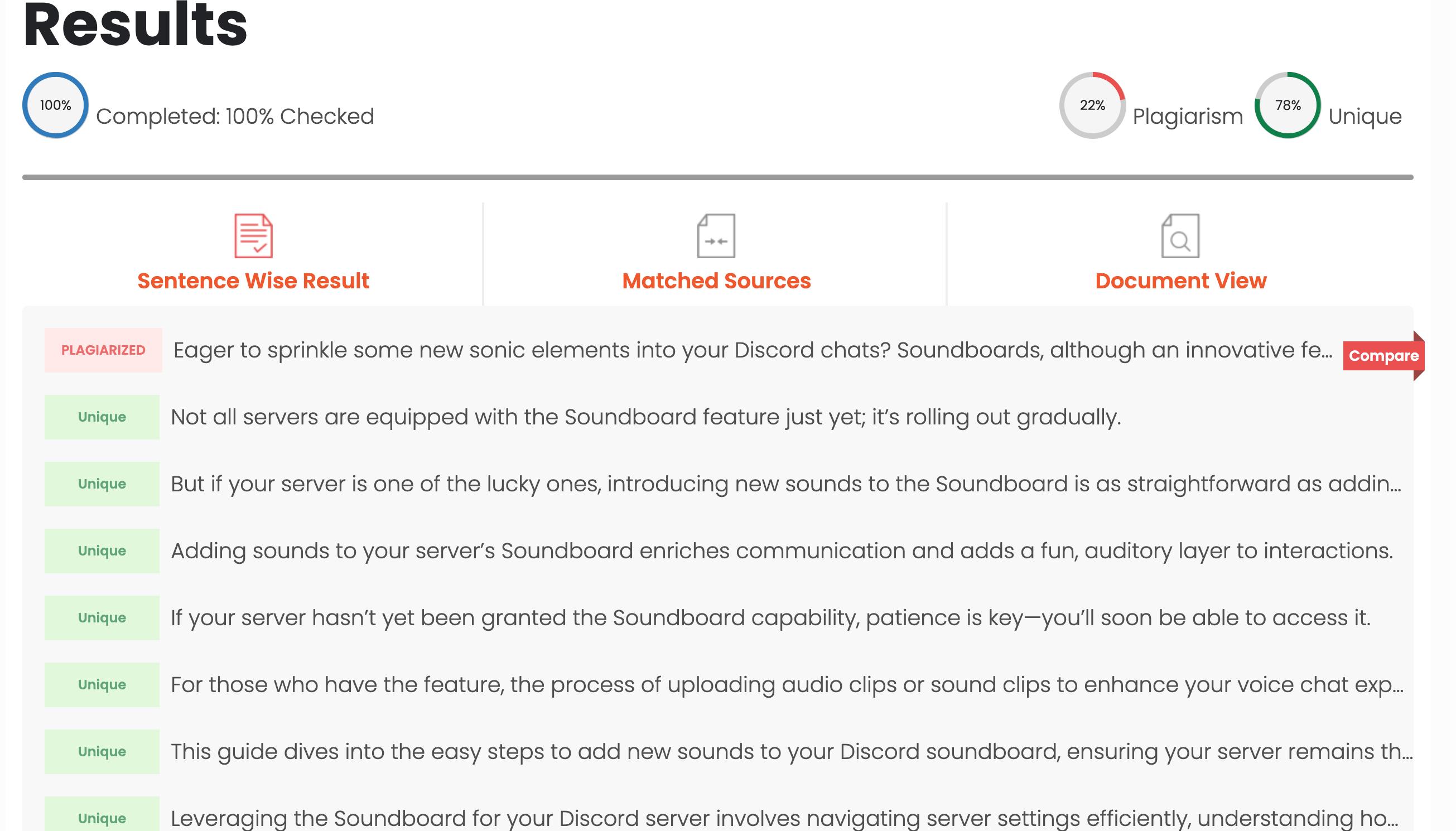
The Importance of Grammar in Plagiarism Detection in 2025
Choose Your Language:
Welcome to an enthralling exploration into the pivotal role of grammar in the realm of plagiarism detection, a topic as timely as it is essential.
In today’s digital age, where information flows freely and writing is more accessible than ever, safeguarding intellectual integrity has become a crucial challenge.
Here, we cast the spotlight not on the advanced plagiarism checkers that scour the web’s vast expanses but on the unsung hero of this tale: grammar.
Yes, the seemingly mundane matter of grammar and sentence structure is, in fact, a formidable ally in detecting and differentiating between original creations and those shadowed by the specter of plagiarism.
This enlightening expedition will unveil how subtle nuances in writing style, punctuation errors, and grammar mistakes can reveal the traces of plagiarism that lurk within texts. From the classrooms echoing with discussions on academic integrity to the echoing halls of academic writing, the importance of a dependable plagiarism checker cannot be overstated.
Whether you’re a diligent student aiming for plagiarism-free work, an educator striving to uphold academic standards, or a curious mind intrigued by the intersections of technology and language, you’ll find this analysis riveting.
With revolutionary tools like Turnitin paste paper check, online plagiarism detectors, and grammar check tools at our disposal, we now possess the power to catch unintentional plagiarism, fix grammar errors, and ensure essays and papers glow with the hallmarks of originality. Yet, amidst these innovations, it’s the meticulous attention to grammatical detail that often catches what the eye misses.
By understanding grammar’s role, enthusiasts and experts alike can elevate their writing, elude the pitfalls of incremental plagiarism, and celebrate the purity of their contributions to the vast ocean of knowledge.
Prepare yourself for a deep dive into how smart algorithms flag grammatical inconsistencies, leading to a revealing plagiarism check, and witness the symbiotic relationship between grammar corrections and plagiarism detection.
This is not just a study; it’s a call to arms for lovers of language and champions of authentic expression.
Get ready for an educational odyssey that will forever change your perspective on grammar plagiarism, and equip you with insights to harness the full potential of writing tools in your quest for originality and excellence.
Check out our Free Plagiarism Tool to Check Plagiarism for free.
1 What is Plagiarism?

Plagiarism, at its core, represents the act of using someone else’s work or ideas without giving them proper credit, a misstep that can compromise academic integrity and the authenticity of one’s contributions.
This unethical practice ranges from copying texts verbatim without quotation marks to adopting significant ideas without adequate citation.
In the realm of academic writing and beyond, understanding the plagiarism definition is fundamental for students, educators, and professionals alike, as it lays the groundwork for recognizing and correcting infractions of intellectual property rights.
Turnitin Review – Is it Worth Your Bucks?
The utilization of a plagiarism checker or a plagiarism detector is paramount in this digital age, where resources like free plagiarism checker tools and online plagiarism checkers like Turnitin paste paper check, offer sophisticated solutions to detect plagiarism and help ensure that written work is plagiarism-free.
By leveraging advanced algorithms to flag grammatical errors, punctuation errors, and inconsistencies in writing style, these tools perform an in-depth check beyond the surface level.
They scan web pages, academic databases, and other resources to compare content for any potential plagiarism, including direct plagiarism, incremental plagiarism, and even unintentional plagiarism, thus highlighting the importance of using citation tools and writing tools effectively.
Proper citation and understanding of self-plagiarism are critical to avoiding the pitfalls of academic dishonesty, and tools equipped with a plagiarism search function and the ability to fix grammar errors provide invaluable support in these endeavors.
Whether through a grammar check tool, a similarity checker, or a direct plagiarism check, the goal remains the same: to produce original, well-cited work that is free from plagiarism and grammar mistakes, ultimately fostering a culture of integrity and respect for intellectual property.
Plagiarism and Citation: is it plagiarism if you cite the source?
2 Grammar in Plagiarism
2.1 Identification of Suspicious Text
Ensuring the accuracy of plagiarism detection necessitates the effective identification of suspicious text. Grammar analysis plays a critical role in this process, aiding in the identification of possible instances of plagiarism.
By scrutinizing sentence structures, grammar inconsistencies, and language usage, plagiarism checker tools like Google’s Plagiarism Checker can flag content that deviates from the norm or exhibits unusual patterns.
Grammarly Review 2024 (Does it live up to the hype?)
For instance, if a sentence in the submitted work mirrors the structure, word choice, and order of a sentence from a different source, it might signal plagiarism.
Detecting such suspicious text is paramount to enhancing the effectiveness of plagiarism detection efforts, thereby upholding academic integrity and preventing unintentional plagiarism.
Quoting, Paraphrasing, and Avoid Plagiarism (With Examples)
2.2 Sentence Structure Analysis
Sentence Structure Analysis is essential in the realm of plagiarism detection, especially when employing tools such as Google’s Plagiarism Checker.
By analyzing the structure of sentences, these innovative tools can pinpoint similarities or deviations that might suggest copied content. If a phrase appears in two different texts with the exact sentence structure, it could serve as a strong indicator of direct plagiarism.
Conversely, variations in sentence structure might also highlight attempts to paraphrase or reword copied material, potentially ticking boxes for incremental plagiarism or even unintentional plagiarism scans.
Thus, by dissecting sentence structure, plagiarism detection tools efficiently flag potential instances of plagiarism, assisting users in maintaining the originality of their work.
How Does the Plagiarism Checker Work? (Detailed Analysis)
2.3 Language Usage Inconsistencies
Plagiarism checker tools, including Google’s, excel at detecting plagiarism by scrutinizing language usage inconsistencies.
Grammar errors such as incorrect verb tenses or inconsistent pronoun usage can signal copied content, while inappropriate word choices or vocabulary inconsistencies may suggest that sections of the text were directly lifted from another source.
Furthermore, variances in writing style, like a sudden shift in tone or vocabulary, can indicate plagiarized material.
By identifying these language usage inconsistencies, tools like the plagiarism checker Google empower users to spot suspicious text and take appropriate corrective actions, thus enabling a plagiarism-free work environment that champions academic integrity and respects intellectual property rights.
12 Best Plagiarism Checkers (All are Free!)
3 Advantages of Grammar Analysis in Plagiarism
3.1 Enhanced Accuracy
The integration of grammar analysis into plagiarism detection, particularly through tools like the free plagiarism checker and plagiarism checker Google, elevates the precision in spotting plagiarized content.
This methodical approach to scrutinizing grammar and sentence structure unveils a deeper layer of text analysis, significantly improving the detection of paraphrased content and subtle linguistic discrepancies.
For instance, changes in sentence phrasing or the choice of words that might otherwise go unnoticed are readily identified, thanks to sophisticated algorithms designed to flag potential plagiarism and grammar errors.
This meticulous attention to detail ensures a thorough in-depth check, bolstering the accuracy of plagiarism results and fostering a plagiarism-free academic environment.
The ability to catch unintentional plagiarism, direct plagiarism, or even incremental plagiarism underscores the vital role of grammar analysis in preserving academic integrity and the authenticity of academic writing.
How to Check Code for Plagiarism (4 Methods)
3.2 Identifying Paraphrased Content
The challenge of identifying paraphrased content is adeptly met by advanced plagiarism checkers like Google’s Plagiarism Checker.
By dissecting the document’s grammar, sentence structure, and writing style, these tools can pinpoint instances where thoughts or expressions have been altered without proper citation.
This could range from a student reshuffling words in a sentence to make it seem original, to a researcher failing to give proper credit for the paper’s main idea.
Modern browser-based plagiarism detectors and online tools like Turnitin paste paper check and free online plagiarism checker tools play a crucial role in mitigating academic dishonesty by effectively detecting and highlighting these subtle attempts at plagiarism.
Their function extends beyond mere detection; they also serve as educational aids, offering spelling errors and grammar suggestions that help improve writing skills and ensure the production of plagiarism-free work.
In this regard, the plagiarism detection tool does not only serve as a paper checker but becomes a comprehensive writing assistant that assists in honing writing issues, thus encouraging proper citation practices and academic honesty.
7 Types of Plagiarism (with Examples & Tips to Avoid)
4 The Limitation of Grammar in Plagiarism
4.1 Contextual Understanding
While powerful tools such as the plagiarism checker Google have revolutionized the way we approach plagiarism detection through robust grammar plagiarism tools and sentence structure analysis, they are not without limitations.
A significant hurdle is their often limited contextual understanding. For instance, accurate algorithms flag grammar and potential plagiarism, but they might misinterpret a widely accepted statement like “Apple revolutionized the smartphone industry” as a duplicate content issue.
Contextual nuances, which are crucial for determining the authenticity of a document’s content, are sometimes overlooked by these automated systems.
This highlights the importance for users to perform an in-depth check, incorporating their judgment to evaluate the contextual legitimacy of flagged sections, thus preventing baseless plagiarism accusations and ensuring a just evaluation of the work’s originality.
How Do Professors Check for Plagiarism? (5 Ways)
4.2 Lack of Plagiarism Intent
Another drawback is the inability of even the best free plagiarism checker to ascertain the intent behind the detected similarities.
These tools, including the renowned plagiarism checker online options such as Turnitin paste paper check and free online plagiarism checker systems, excel at identifying textual similarities and grammar errors.
However, discerning whether such matches result from unintentional plagiarism or are a deliberate act of academic dishonesty is beyond their scope. They can catch unintentional plagiarism; however, establishing intent requires a more nuanced approach.
Evaluating the context of the content, the author’s credibility and historical work, along with the presence of proper citations and references, are critical steps in distinguishing between inadvertent oversights and deliberate plagiarism.
This illustrates the intricate balance between leveraging digital plagiarism detection tools and the indispensable human judgment in upholding academic integrity and fostering plagiarism free work.
5 Frequently Asked Questions
5.1 How can the integration of grammar analysis improve the accuracy of a plagiarism checker?
The incorporation of grammar analysis into a plagiarism detection tool, such as a grammar checker or a plagiarism checker online, substantially enhances its ability to identify not only direct and incremental plagiarism but also unintentional plagiarism.
By examining the grammar and sentence structure, these advanced algorithms flag grammar inconsistencies and subtle linguistic shifts, significantly raising the precision of plagiarism results and helping to maintain academic integrity.
5.2 What makes modern plagiarism detectors capable of identifying paraphrased content?
Modern plagiarism checkers, including free plagiarism checker tools and those with a focus on grammar plagiarism, leverage sophisticated algorithms to dissect and analyze the document’s writing style, sentence structure, and grammatical patterns.
This allows them to detect paraphrased content that may not directly match source material but still constitutes plagiarism.
Tools like Turnitin paste paper check and various online plagiarism checker platforms are instrumental in spotting these nuanced attempts at academic dishonesty.
5.3 Can plagiarism detection tools truly understand the context of the content they analyze?
While plagiarism detection tools, including plagiarism checker free and grammar check tool offerings, are adept at identifying potential plagiarism and grammar mistakes, they sometimes lack the contextual understanding necessary to differentiate between common knowledge and plagiarized material.
This highlights the need for users to review flagged content manually, ensuring that accusations of plagiarism are substantiated by a thorough in-depth check of the context and originality of the work.
5.4 How do plagiarism checkers handle the detection of unintentional plagiarism without establishing intent?
Plagiarism detection tools can efficiently catch unintentional plagiarism by identifying textual similarities and grammar errors.
However, discerning the intention behind these similarities requires human judgment.
By evaluating the content’s context, the author’s previous work, and the adequacy of citations and references, users can distinguish between inadvertent oversight and deliberate plagiarism, underscoring the balance between using digital tools and human evaluation in promoting plagiarism-free work.
5.5 Is it possible for grammar and sentence structure analysis to catch every instance of plagiarism?
While advancements in plagiarism detection technology, including the use of grammar checkers and plagiarism check tools, have significantly improved the ability to detect plagiarism, including direct, incremental, and paraphrased content, no tool is infallible.
The subtle nuances of language and the vastness of the plagiarism database mean that in-depth checks and human oversight remain crucial for ensuring the comprehensive identification of plagiarism and upholding the standards of academic writing.
6 Conclusion
In conclusion, the evolution of plagiarism detection technology has significantly enhanced the capability of individuals and institutions to uphold academic integrity.
Sophisticated plagiarism tools integrated with advanced grammar checker functionalities, such as those found in both paid and plagiarism checker free platforms, are at the forefront of this innovation.
They not only define plagiarism with precision but also refine the process of identifying both intentional and unintentional plagiarism.
However, the essence of combating plagiarism effectively lies in the balanced synergy between using these digital tools and applying human judgment.
By conscientiously applying these resources, users can ensure a thorough unintentional plagiarism scan, fostering a culture of originality and ethical academic practice.




